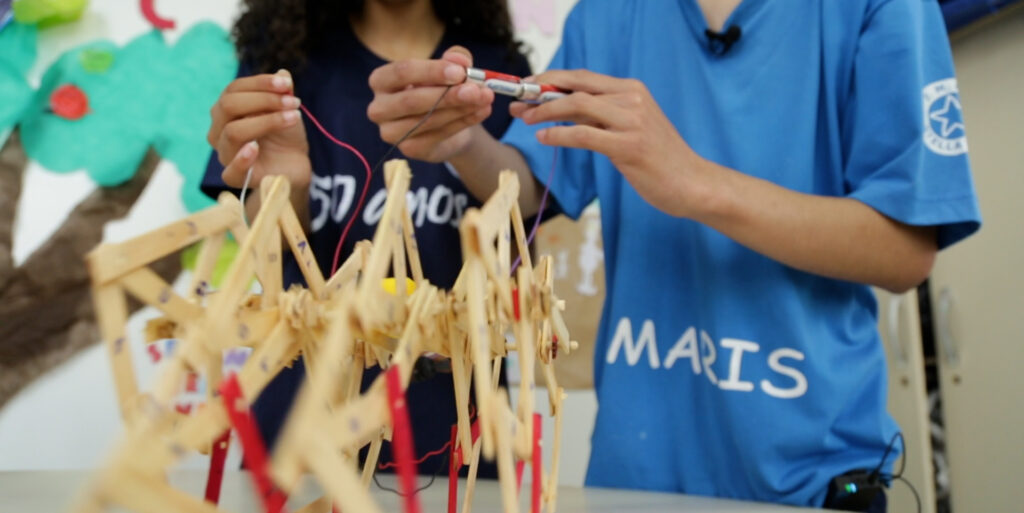About Creative Learning

In the Creative Schools Program, our work is primarily guided by an educational approach called Creative Learning, which promotes the creation of more exploratory, investigative, and playful learning experiences and spaces. This approach encourages students to develop creative thinking, curiosity, and inventiveness.
Proposed by Mitchel Resnick, coordinator of the Lifelong Kindergarten Group at MIT Media Lab, Creative Learning is mainly based on Seymour Papert’s Constructionism, also from MIT, which was inspired by the ideas of Piaget, Paulo Freire, Montessori, and other great references in the field of education.
This approach has four pillars that guide the creation of learning experiences and environments, known as the 4 Ps: Projects, Passion, Peers, and Play. In other words, it is based on the principle that students learn best when they have the opportunity to create something (PROJECT) that is personally meaningful (PASSION), whether it’s a car, a poem, or a computer program. This process becomes even richer when they are encouraged to exchange ideas and collaborate with others (PEERS) and to explore the materials and concepts involved in the project in a playful and exploratory manner (PLAY).
It is worth noting that constructing something, or creating a project, always involves a creative process. This process allows students to develop ideas, concepts, or artifacts, as well as express themselves and voice their thoughts in an ongoing learning process known as the Creative Learning Spiral. During this process, they can IMAGINE and come up with many ideas to put into practice through the challenge of CREATING. However, this creation is not limited to the school context, allowing students to engage in a playful and exploratory manner, where they can PLAY, feel a sense of belonging, and connect while conducting their intellectual experiments. When projects extend beyond the school walls and the learning environment encourages collaboration, students have a greater desire to SHARE their creations, present their ideas, and publicize their discoveries. This sharing process, when properly mediated, provides opportunities for students to REFLECT on their creations and return to IMAGINING new ideas, forms of expression, or creations, thus allowing the spiral to continue its course.
In addition to the 4Ps and the creativity spiral, there is a third important principle of Creative Learning, which we often refer to as the “creativity house”. This concept supports the design of learning experiences and spaces that provide opportunities for all students to begin free exploration immediately. This means that the activity must have a low floor, starting with challenges that are achievable for everyone, while also allowing them to work on projects with increasing complexity (high ceiling). Additionally, it offers the possibility for them to pursue various paths and forms of expression (wide walls).
PROJECTS
In the Creative Schools program, we understand a project as a construction created by students that is connected to a curricular theme and, at the same time, personally relevant to them. There is no step-by-step guide that results in identical or very similar constructions; instead, there is space for the exercise of autonomy and creative freedom and for the exploration of different ideas and materials in a playful way. This process happens collaboratively, even if the creations are individual, in an atmosphere of exchanges and sharings. Understood this way, the project can offer rich contexts for learning curricular content. When the student creates something concrete in the world (whether real or virtual), this project becomes an external representation of the ideas in their head, a materialization of their thoughts. So, in this process of creation and refinement, they play not only with what is being built but also with the very ideas that permeate this construction, gaining a better understanding of the involved concepts, building meanings, and understanding the possibilities and limitations of what they know. This is what makes these hands-on activities so important for the learning process in constructionism and Creative Learning.
CONSTRUCTIONISM
Constructionism is an educational theory proposed by Seymour Papert, which argues that the activity of creating or constructing things and projects provides a rich context for learning. According to the researcher, children learn best when they discover the specific knowledge they need on their own. And the type of knowledge they most need is precisely what will help them gain more knowledge, with a fundamental role of the school being to develop the art of learning, which Papert called mathetics. Constructionism’s main characteristic is investigating the idea of mental construction, giving special importance to the role of constructions in the world as support for what is being built in the mind. No matter what project is being created, it can be a model, a scientific article, a poem, a bread recipe, the programming of an automatic irrigator for the school garden, anything that is personally significant or relevant to the people around. When we create something concrete in the world (whether real or virtual), this project becomes an external representation of the ideas in our head, a materialization of our thinking. So, in this process of creation and refinement, we play not only with what is being built but also with the very ideas that permeate this construction, gaining a better understanding of the involved concepts, building meanings, and understanding the possibilities and limitations of what we know.
If you want to hear Papert himself talk about the essence of Constructionism, watch the following video 🙂